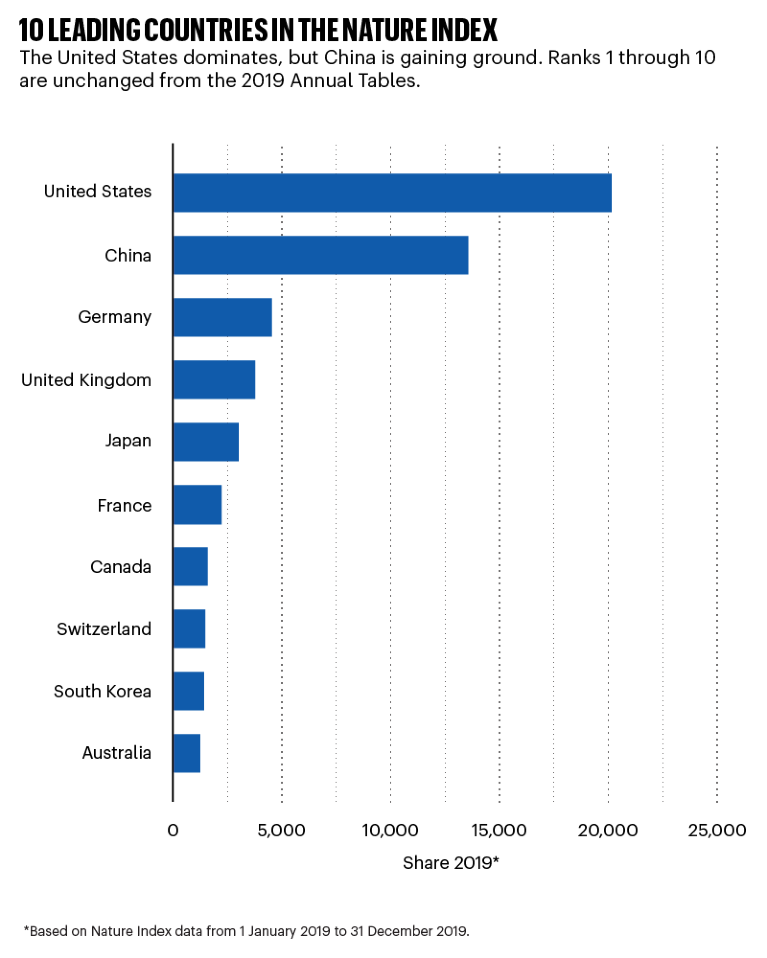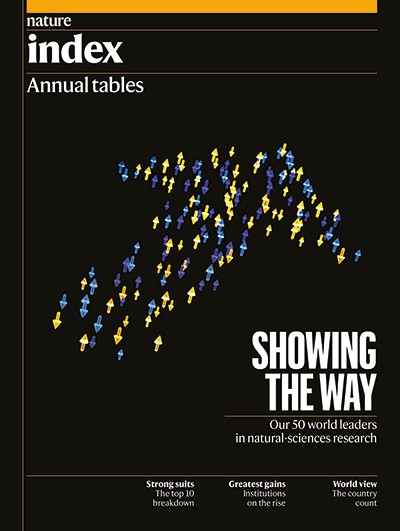
A scientist examines information on COVID-19 as part of vaccine research at the Pasteur Institute laboratories.Credit: Adrienne Surprenant/Bloomberg/Getty
The United States is the most prolific publisher of high-quality natural-sciences research in the Nature Index, but China is closing the gap with remarkable speed (see Graphic).
In the Nature Index 2020 Annual Tables, the United States’ Share is 20,152.48, which represents a 4.2% decrease in adjusted output from the previous year. China’s Share, on the other hand, jumped from 11,372.26 to 13,566.11 over the same period, a 15.4% increase. See the 2020 Annual Tables Top 100 countries for 2019.
(Share, formerly referred to in the Nature Index as Fractional Count (FC), is a measure of an entity’s contribution to articles in the 82 journals tracked by the index, calculated according to the proportion of its affiliated authors on an article relative to all authors on the article. When comparing data over time, Share values are adjusted to 2019 levels to account for the small annual variation in the total number of articles in the Nature Index journals. The Nature Index is one indicator of research performance. See Editor’s note below.)

Source: Nature Index
1. United States
Share: 20,152.48; Count: 28,403; Change in adjusted Share (2018–19): −4.2%
The United States’ Share in the Nature Index was marginally down in 2019, but it continues to be bolstered by its top-performing institutes: Harvard University in Cambridge, Massachusetts; Stanford University in Stanford, California; the Massachusetts Institute of Technology in Cambridge, Massachusetts; and the National Institutes of Health.
The life sciences accounts for almost 50% of the nation’s Share in the natural sciences. In 2019, the biggest collaborative partners of the United States were China, the United Kingdom and Germany; smaller countries, Australia and Switzerland, also made it into its top 10 collaborators list.
In the Nature Index 2020 Annual Tables, the United States topped the rankings in the life, physical, and Earth and environmental sciences.
2. China
Share: 13,566.11; Count: 18,026; Change in adjusted Share (2018–19): +15.4%
China is the second strongest and the fastest-rising country in the Nature Index 2020 Annual Tables.
Nature Index 2020 Annual Tables
Although chemistry accounts for more than 50% of China’s output in the Nature Index, the physical sciences are also a major strength.
The country’s top performing institutions across all natural-sciences disciplines are the Chinese Academy of Sciences in Beijing, the University of Science and Technology of China in Hefei, Peking University in Beijing, Tsinghua University in Beijing, and Nanjing University in Nanjing, all of which fall within the top 25 of global institutions in the Nature Index.
In the 2020 Annual Tables, China topped the rankings in chemistry.
3. Germany
Share: 4,545.70; Count: 8,770; Change in adjusted Share (2018–19): −4.1%
With two institutions among the Nature Index top 10 global institutions, Germany is a force in high-quality research publishing.
Its most prolific institution in the Nature Index, the Max Planck Society, based in Munich, featured in the top 5 in the physical sciences, chemistry and life-sciences categories in the 2020 Annual Tables, and placed third overall.
Germany hosts more than 1,000 publicly funded research institutions and around 400 higher-education institutions, which contribute to its status as a desired destination for researchers. It also boasts a relatively low cost of living, stable growth, and high research and development (R&D) spending.
4. United Kingdom
Share: 3,773.66; Count: 7,837; Change in adjusted Share (2018–19): −2.7%
As Nature reported in January, Brexit has already disrupted research in the United Kingdom. That said, the country remains one of the world’s best in producing high-quality research in the natural sciences, retaining its long-standing fourth rank in the Nature Index Top 50 Countries/Territories table.
The United Kingdom’s top institutions in the Nature Index include the University of Cambridge and the University of Oxford, which are ranked in the top 25 global institutions in the 2020 Annual Tables, and Imperial College London and University College London, which are ranked 48th and 50th, respectively.
Its top collaborators in 2019 were the United States, Germany and China, and the life sciences is its strongest subject in the Nature Index.
5. Japan
Share: 3,024.32; Count: 4,905; Change in adjusted Share (2018–19): −5.1%
Japan is working hard to retain its position in the global research ranks. As Nature Index reported in 2019, its strategy of funding selected institutions to boost their overseas collaboration has begun to bear fruit, as the nation continues to look outwards in an effort to arrest the decline in its high-quality scientific research output.
Japan’s top-performing institutes are the University of Tokyo, Kyoto University, Osaka University and the Tokyo Institute of Technology.
Japan’s research performance was the focus of a 2019 Nature Index supplement, which revealed an increase in its proportion of articles co-authored with international researchers. However, correcting the slide in its Share is proving difficult for the nation.
6. France
Share: 2,238.55; Count: 5,054; Change in adjusted Share (2018–19): −1.6%
France’s strengths in the natural sciences are diverse, with chemistry, physical sciences and life sciences accounting for roughly equal shares in its high-quality research output, followed by Earth and environmental sciences.
In 2019, its highest-performing institute, the government’s French National Centre for Scientific Research (CNRS) in Paris (ranked fourth overall in the 2020 Annual Tables), had more than six times the Share of its second-highest performing institute, Sorbonne University (ranked 127th), also based in Paris.
The CNRS is not only France’s premier research institute, it also shines on the world stage, ranking highly in the physical sciences, Earth and environmental sciences, and chemistry in the 2020 Annual Tables.
7. Canada
Share: 1,602.09; Count: 3,408; Change in adjusted Share (2018–19): −4.4%
Canada is one of a number of high-ranking countries that saw a downturn in Share in the Nature Index 2020 Annual Tables, but it has held seventh place consistently since 2015.
Among the nation’s top-performing institutions are the University of Toronto, McGill University in Montreal, and the University of British Columbia in Vancouver. Its most favoured research partners in 2019 were the United States, China and the United Kingdom.
Between 2017 and 2018, Canadian universities received an influx of international students and researchers, with the number of students from overseas increasing by 1.9% in just one year. At the University of Toronto, 21.3% of all students were international students in the 2017–18 enrolment year.
8. Switzerland
Share: 1,487.88; Count: 3,270; Change in adjusted Share (2018–19): +1.2%
For a nation of just 8.4 million people, Switzerland’s high-quality research output is impressive. In the Nature Index 2020 Annual Tables, it is the seventh fastest rising country in the world.
The Swiss Federal Institute of Technology Zurich (ETH Zurich) and the Swiss Federal Institute of Technology Lausanne (EPFL) are the nation’s top-performing institutions in the Nature Index.
Switzerland is also home to F. Hoffmann-La Roche and Novartis International, both based in Basel, which are the top performing corporate institutions in the Nature Index for biomedical sciences.
9. South Korea
Share: 1,435.23; Count: 2,419; Change in adjusted Share (2018–19): +2.8%
South Korea is one of the most innovative countries in the world, according to the Global Innovation Index. It spends 4.3% of its gross domestic product on R&D.
In the Nature Index it is a major player in chemistry and the physical sciences, which together make up more than 95% of its total Share.
South Korea’s biggest collaborative partners in 2019 were the United States, China and Japan. The Seoul National University and the Korea Advanced Institute of Science and Technology in Daejeon are its top performers in the Nature Index 2020 Annual Tables.
10. Australia
Share: 1,259.95; Count: 2,986; Change in adjusted Share (2018–19): −2.8%
Australia has maintained its position as the tenth biggest producer of natural-sciences research in the Nature Index for two consecutive years.
The country’s output by subject is fairly evenly spread, although the life sciences contributed the most to its overall Share in the Nature Index.
Monash University in Melbourne is the best-performing Australian institution in terms of output in the 82 selected journals tracked by the Nature Index, followed by the University of New South Wales in Sydney and the University of Queensland in Brisbane.

 Show of strength
Show of strength
 Fastest movers since 2015
Fastest movers since 2015
 Ten countries with high-performing hubs of natural-sciences research
Ten countries with high-performing hubs of natural-sciences research
 Leading research institutions 2020
Leading research institutions 2020
 Fast-rising research institutions 2020
Fast-rising research institutions 2020
 Fast-rising academic institutions 2020
Fast-rising academic institutions 2020
 Rising stars in life sciences 2020
Rising stars in life sciences 2020
 Rising stars in chemistry 2020
Rising stars in chemistry 2020
 Rising stars in physical sciences 2020
Rising stars in physical sciences 2020
 Rising stars in Earth and environmental sciences 2020
Rising stars in Earth and environmental sciences 2020





